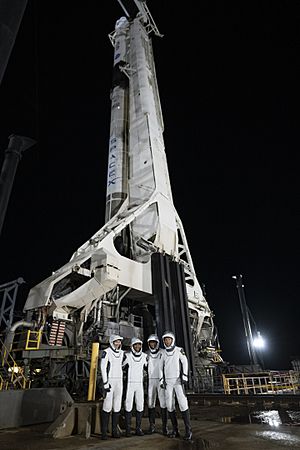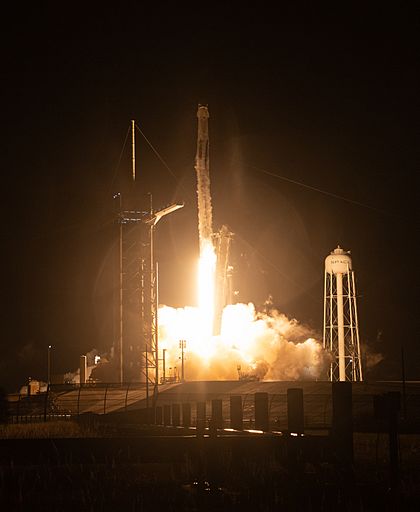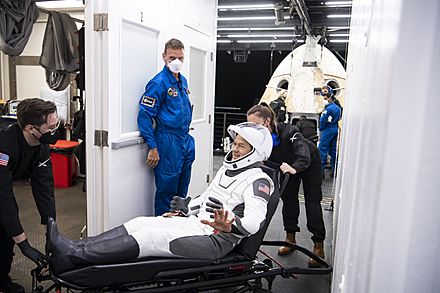SpaceX Crew-3 facts for kids
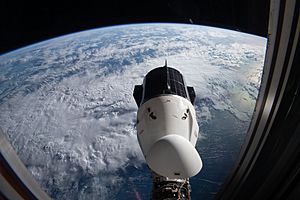
Crew Dragon Endurance docked to the ISS during Crew-3
|
|
| Names | USCV-3 |
|---|---|
| Mission type | ISS crew transport |
| Operator | SpaceX |
| Mission duration | 176 days, 2 hours and 39 minutes |
| Spacecraft properties | |
| Spacecraft | Cargo Dragon |
| Spacecraft type | Crew Dragon |
| Manufacturer | SpaceX |
| Launch mass | 12,055 kg (26,577 lb) |
| Crew | |
| Crew size | 4 |
| Members |
|
| Expedition | Expedition 66 / 67 |
| Start of mission | |
| Launch date | 11 November 2021, 02:03:31 UTC |
| Rocket | Falcon 9 Block 5 (B1067.2) |
| Launch site | Kennedy Space Center, LC-39A |
| Contractor | SpaceX |
| End of mission | |
| Recovered by | Shannon |
| Landing date | 6 May 2022, 04:43 UTC |
| Landing site | Gulf of Mexico |
| Orbital parameters | |
| Reference system | Geocentric orbit |
| Regime | Low Earth orbit |
| Inclination | 51.66° |
| Docking with International Space Station | |
| Docking port | Harmony forward |
| Docking date | 11 November 2021, 23:32 UTC |
| Undocking date | 5 May 2022, 05:20 UTC |
| Time docked | 174 days and 6 hours |
 SpaceX Crew-3 mission patch 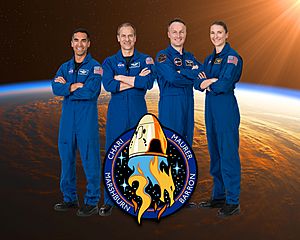 Chari, Marshburn, Maurer and Barron Commercial Crew Program
|
|
SpaceX Crew-3 was an important space mission by SpaceX. It was the fourth time a Crew Dragon spacecraft flew with astronauts. This mission was part of the Commercial Crew Program, which helps send astronauts to the International Space Station (ISS).
The Crew-3 mission successfully launched on November 11, 2021. It carried four astronauts to the ISS. This flight was special because it was the very first journey for the new Crew Dragon capsule named Endurance. When Matthias Maurer and Kayla Barron flew on this mission, they became the 600th and 601st people to ever travel to space!
What's in a Name?
SpaceX Crew Dragon capsules are given special names by their first crews. The first one was called Endeavour, and the second was Resilience.
On October 7, 2021, it was announced that the third capsule would be named Endurance. This name was chosen for two main reasons:
- It honored the hard work of the SpaceX and NASA teams. They kept working through the COVID-19 pandemic to build the spacecraft and train the astronauts.
- It also honored a famous ship called Endurance. This ship was used by explorer Ernest Shackleton on his trip to Antarctica in 1915. The ship got stuck in ice and sank, but the crew showed amazing endurance to survive.
Meet the Crew
Four astronauts flew on the SpaceX Crew-3 mission. They were:
- Raja Chari (from NASA, USA)
- Thomas Marshburn (from NASA, USA)
- Matthias Maurer (from ESA, Germany)
- Kayla Barron (from NASA, USA)
Matthias Maurer was the first astronaut chosen for this mission in September 2020. Raja Chari and Thomas Marshburn joined the crew in December 2020. The fourth seat was later given to Kayla Barron in May 2021.
Raja Chari was the first new astronaut to lead a NASA space mission since 1973. This was also the first time in space for Matthias Maurer and Kayla Barron.
| Position | Astronaut | |
|---|---|---|
| Spacecraft commander | Expedition 66 / 67 First spaceflight |
|
| Pilot | Expedition 66 / 67 Third spaceflight |
|
| Mission specialist 1 | Expedition 66 / 67 First spaceflight |
|
| Mission specialist 2 | Expedition 66 / 67 First spaceflight |
|
| References: | ||
| Position | Astronaut | |
|---|---|---|
| Spacecraft commander | ||
| Pilot | ||
| Mission specialist 1 | ||
| Mission specialist 2 | ||
| References: | ||
The Zero-G Turtle
Astronauts often bring a small toy with them to space. This toy floats when the spacecraft reaches space, showing that there is no gravity (zero-g). For the Crew-3 mission, Raja Chari and Kayla Barron brought a stuffed turtle. This was a tribute to their astronaut group, nicknamed The Turtles.
To include the other crew members, Matthias Maurer and Thomas Marshburn, the turtle was named "Pfau." This is a German word for "Peacock," honoring Matthias Maurer (who is German) and Thomas Marshburn (whose astronaut group was nicknamed The Peacocks).
The Mission Journey
The Crew-3 mission was originally planned to launch on October 31, 2021. However, it faced several delays:
- Bad weather in the Atlantic Ocean pushed the launch to November 3.
- A small medical issue with one of the astronauts delayed it further to November 7.
- More bad weather predictions caused another delay to November 9.
Because of these delays, NASA decided to bring the astronauts from the previous mission, Crew-2, back to Earth before Crew-3 launched. This was the first time a Crew Dragon mission did not directly swap crews at the space station.
Finally, the SpaceX Crew-3 mission launched from Cape Canaveral on November 11, 2021. The astronauts spent 176 days living and working on the International Space Station.
Their return to Earth was also delayed a few times. The Crew Dragon Endurance undocked from the ISS on May 5, 2022. The next day, on May 6, the capsule successfully splashed down in the Gulf of Mexico, bringing the astronauts safely home.
The European part of Matthias Maurer's mission was called "Cosmic Kiss."
See also
 In Spanish: SpaceX Crew-3 para niños
In Spanish: SpaceX Crew-3 para niños


